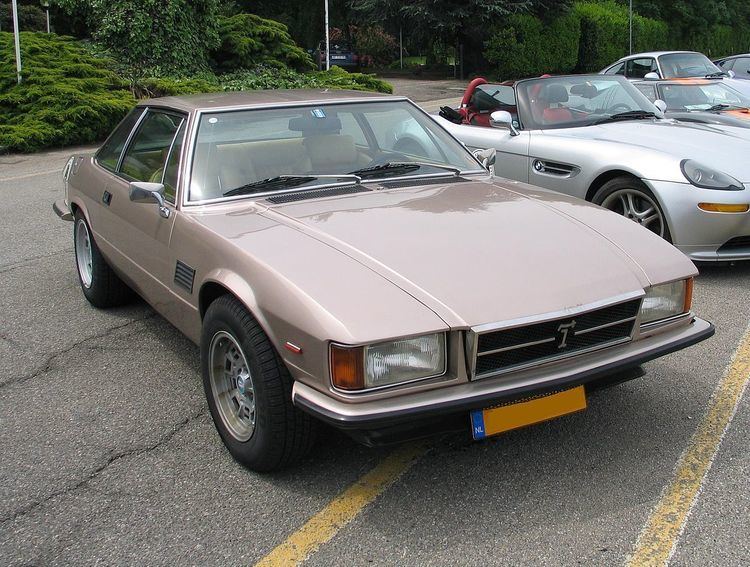Layout FR layout | Production 1972–1989 | |
 | ||
Body style 2-door coupé2-door convertible | ||
The De Tomaso Longchamp is an automobile which was produced by the Italian automaker De Tomaso from 1972 to 1989.
Contents
History
The Longchamp was developed from the De Tomaso Deauville four-door sedan, using a shorter wheelbase chassis with the same suspension, engine and transmission. The two models were the only front-engined production cars produced by De Tomaso. The Longchamp was first exhibited at the 1972 Turin Motor Show and was initially offered only as a two-door 2+2 coupé. It was designed by Tom Tjaarda of Ghia and was influenced by his previous Lancia Marica prototype. The taillights were the same units as were used for the Alfa Romeo 1750/2000 saloon. The headlights and front indicators are from Ford of Europe Models Ford Consul / Granada. The name Longchamp is likely a reference to the Longchamp Racecourse in Paris and/or Longchamps, a city near de Tomaso company founder Alejandro de Tomaso's Buenos Aires birthplace.
The Longchamp featured a long and wide hood to accommodate the American power train, i.e. the 351 cubic inch (5,769 cc) Ford Cleveland V8. The 351 Cleveland, a popular and very potent engine in early 1970s Ford "muscle cars," was the same unit as that used in the Pantera. It produced a minimum of 330 hp (246 kW) and gave the Longchamp an official 240 km/h (149 mph) top speed. The standard gearbox was a three-speed Ford C-6 Cruise-o-Matic automatic gearbox, however around 17 cars were equipped with a five-speed ZF manual gearbox. The suspension was independent front and rear with coil spring and wishbone suspension. Steering was power assisted rack and pinion with vented disc brakes all around, the rear discs being positioned inboard. The interior of the car was quite luxurious and it was almost fully covered with leather, although the use of Ford's partsbin (steering wheel, gear shift) took away somewhat of the luxurious impression.
Development
Production of the Series 1 began in 1973. For 1980 the modernized series 2 was introduced, with slight modifications occurring later as well.
A Longchamp GTS variant was introduced at the 1980 Turin Motor Show, featuring wider wheels and flared wheel arches and minor suspension setting differences to better utilize the wider Campagnolo wheels with Pirelli P7 tyres. A Longchamp cabriolet variant ("Spyder") also appeared at the 1980 Turin Motor Show. It was made by Carrozerria Pavesi of Milan, and a small number of Spyders were built to GTS specifications. Pavesi also converted a number of older coupés to Spyders.
After supplies of American-built 351 V8s dried up, De Tomaso began sourcing their engines from Australia, to where the production line had been transferred. The engines were tuned in Switzerland before being installed, and were available with outputs of 270, 300, or 330 PS (199, 221, or 243 kW). In the eighties another version also appeared, the GTS/E. This was the top version, fitted with twin round headlights and extra spoilers, skirts, and a rear wing.
A total of 409 Longchamps were built (395 coupés and 14 spyders) between 1972 and 1989, with only a couple per year built during the last years. The vast majority are of Series 1 specifications. Some claim that production actually came to an end in 1986, with later cars being sold from stock. The Maserati Kyalami, which was also developed from the Maserati Quattroporte chassis, and conceived just as Alejandro de Tomaso took over Maserati, was very similar i.e. mechanically virtually identical to the Longchamp. The Kyalami however used a Maserati V8, rather than the Ford unit favoured by De Tomaso.
